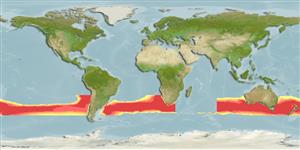>
Zeiformes (Dories) >
Oreosomatidae (Oreos) > Oreosomatinae
Etymology: Neocyttus: Greek, neos = new + Greek, kyttaros, kytos = a convex cavity.
Environment: milieu / climate zone / depth range / distribution range
Écologie
marin bathypélagique; océanodrome (Ref. 51243); profondeur 200 - 1240 m (Ref. 6390), usually 450 - 800 m (Ref. 30191). Deep-water; 23°S - 48°S, 81°W - 176°W
Southeast Atlantic: off Walvis Bay, Namibia to Cape Province, South Africa. Southwest Atlantic: off Argentina. Eastern Indian Ocean: southern Australia, from about 26°S in Western Australia to Broken Bay (Ref. 7300), New South Wales. Southwest Pacific: New Zealand.
Length at first maturity / Taille / Poids / Âge
Maturity: Lm 34.0, range 29 - ? cm
Max length : 40.0 cm SL mâle / non sexé; (Ref. 30191); poids max. publié: 2.0 kg (Ref. 6390); âge max. reporté: 100 années (Ref. 27140)
Épines dorsales (Total): 7; Rayons mous dorsaux (Total): 33-35; Épines anales 3-4; Rayons mous anaux: 30 - 33. Body grey, fins dark (Ref. 6548).
Inhabit continental slopes (Ref. 9563), forming large shoals over rough ground near pinnacles and canyons (Ref. 6390). Juveniles are pelagic and tend to be dispersed over smooth grounds (Ref. 6390). Feed on salps, fish, crustaceans and squid (Ref. 27230). Eggs float near the surface and larvae also inhabit surface waters (Ref. 6390).
Life cycle and mating behavior
Maturité | Reproduction | Frai | Œufs | Fécondité | Larves
Displays seasonally synchronised reproduction.
Karrer, C., 1990. Oreosomatidae. p. 637-640. In J.C. Quero, J.C. Hureau, C. Karrer, A. Post and L. Saldanha (eds.) Check-list of the fishes of the eastern tropical Atlantic (CLOFETA). JNICT, Lisbon; SEI, Paris; and UNESCO, Paris. Vol. 2. (Ref. 6545)
Statut dans la liste rouge de l'IUCN (Ref. 130435)
Menace pour l'homme
Harmless
Utilisations par l'homme
Pêcheries: intérêt commercial mineur
Plus d'informations
RéférencesAquacultureProfil d'aquacultureSouchesGénétiqueElectrophoresesHéritabilitéPathologiesTraitementNutrientsMass conversion
CollaborateursImagesStamps, Coins Misc.SonsCiguateraVitesseType de nageSurface branchialeOtolithesCerveauxVision
Outils
Articles particuliers
Télécharger en XML
Sources Internet
Estimates based on models
Preferred temperature (Ref.
123201): 5 - 9.7, mean 7.8 °C (based on 131 cells).
Phylogenetic diversity index (Ref.
82804): PD
50 = 0.5635 [Uniqueness, from 0.5 = low to 2.0 = high].
Bayesian length-weight: a=0.01698 (0.00988 - 0.02919), b=3.01 (2.85 - 3.17), in cm total length, based on LWR estimates for this species & (Sub)family-body (Ref.
93245).
Niveau trophique (Ref.
69278): 3.6 ±0.53 se; based on food items.
Generation time: 36.7 ( na - na) years. Estimated as median ln(3)/K based on 1
growth studies.
Résilience (Ref.
120179): Très faible, temps minimum de doublement de population supérieur à 14 ans (tmax=100).
Fishing Vulnerability (Ref.
59153): High to very high vulnerability (70 of 100).
Climate Vulnerability (Ref.
125649): Moderate vulnerability (41 of 100).
Nutrients (Ref.
124155): Calcium = 20.2 [5.5, 57.2] mg/100g; Iron = 0.309 [0.117, 1.001] mg/100g; Protein = 17.6 [14.8, 20.6] %; Omega3 = 0.165 [0.052, 0.476] g/100g; Selenium = 16.5 [4.2, 62.1] μg/100g; VitaminA = 43.9 [3.7, 529.6] μg/100g; Zinc = 0.597 [0.279, 1.328] mg/100g (wet weight);
